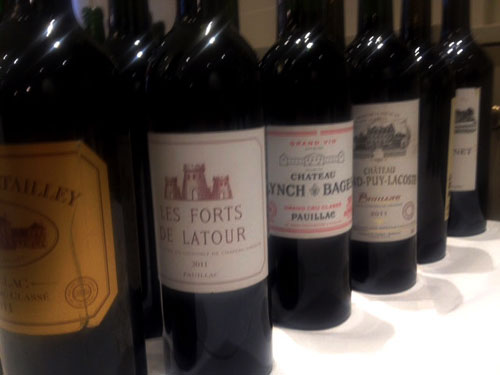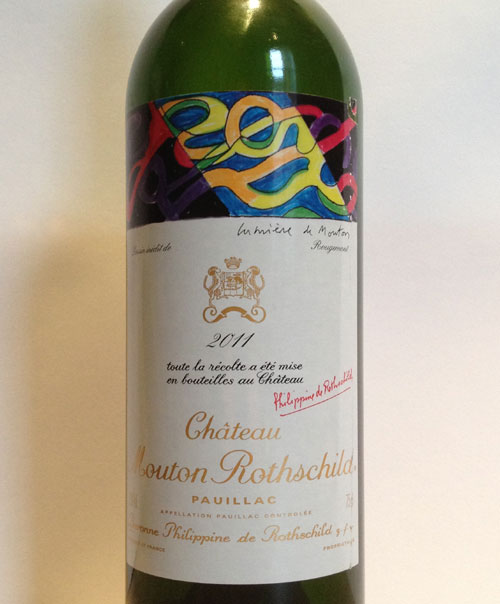For a quarter of a century now I have spent a few days every January in the picturesque seaside town of Southwold with a group of British wine importers and wine writers as we taste through the latest Bordeaux vintage to be physically released. This year our group included no less than six Masters of Wine and wine writers Steven Spurrier of “Decanter”, Neal Martin of “The Wine Advocate” and Julia Harding of “JancisRobinson.com”. No doubt, their comprehensive reports will appear shortly. The vintage up for review this year was 2011. As usual, the wines were tasted blind in random order within peer-groups with the names of the wines not revealed until after the scores were taken. There were 23 flights this year in what was a marathon event. We started at 9.00 am on the Wednesday and finished at 12 noon on the Friday with close to 300 wines being tasted during the three days. A second bottle was also tasted of any wine that we felt was not performing as it should.

The Swan Hotel, Southwold in January 2015
|
2011 is a controversial vintage mainly because it was released at the wrong prices. The Bordeaux proprietors, flush with the astonishing success of the 2009 and 2010 en primeur campaigns (truly great wines at very high prices), failed to understand that in this vintage they needed to revert to the release prices of the 2007’s. Many of them made serious mistakes at the time which make their wines unsaleable today – except at a loss. The worst offenders were the First Growths who released at around 50% higher than they had done in 2007. The second growths, like lemmings jumping over a cliff, mainly followed suit. For example, Cos d’Estournel’s release price for their 2011 was 70% more expensive than for their 2007. On the barest of margins we were forced to sell it at £1200 whereas good vintages like 2006 were (and still are) available at under £800.
Consequently, before anyone had even tasted 2011 Bordeaux from the bottle there was inevitable resentment towards the vintage. Unfortunately, this bad feeling didn’t really go away after 3 days of tasting them last week.

Blind tasting in progress. Exam-like conditions.
|
So, let’s be honest about 2011. It’s not a great vintage. Bordeaux doesn’t really do bad vintages any more (or so we thought until 2013 came along) and 2011 is nothing like as rubbish as the years that were around when I started out in the wine trade. (1972, 1973, 1974, 1977, 1980, 1984, etc.). In fact, if this vintage had been made even as late as the 1990’s it would be seen as a decent year. It’s better than 1991, 1992, 1993, 1994 and 1997 and probably on a level with 1998 and 1999. However it’s not the early-maturing user-friendly vintage (like 2007) that we had hoped. The wines, in general, are quite lean with fairly firm, tannic structure that currently out-muscles the medium-weight fruit. It’s a vintage in which to avoid most second wines and it’s a vintage in which to buy with care. There are actually some rather good wines if you pick and choose wisely.
We started on the right bank with some generally un-inspiring Saint Emilions. However, when we reached the top names there were some very pleasant surprises. The winning wines here were Angélus and Tertre Roteboeuf. These two have genuinely plump ripe fruit in balance with the structure. Figeac was very good and seductive too. The real disasters here were made by the people who like to soup up their wines with manufactured “extraction” in the winery. As the old saying goes, "if you concentrate crap, you get concentrated crap". Wines such as Grand Mayne, Peby Faugères, La Couspaude and Pavie Decesse received groans of dis-approval (and some extremely low scores) and tasted absolutely nothing like Saint Emilion. These are wines to avoid.

2011 samples
|
The Pomerols, overall, were a bit better and the top rated wines here were Le Pin (overall winner of the whole event), Vieux Château Certan and La Conseillante. The big surprise on the right bank was the exceptional performance of Denis Durantou’s smooth and sexy Lalande de Pomerol – Les Cruzelles. Despite this being one of the cheapest wines in the entire tasting, it beat over 50 more famous and expensive Pomerols and Saint Emilions in the scoring, as well as many distinguished classed growths. At £150 per dozen this is the bargain buy of the vintage.
In the Northern Médoc it is impressive how the top Châteaux always stand out in these tastings and deliver the goods. It’s often hard to spot the big names when tasted blind, but in Saint Estèphe it seems that Cos d’Estournel or Montrose come out winners every year. This year it was the turn of Cos to come out on top with Calon Ségur and Montrose just behind.
In Pauillac there was a superb performance from Pichon Baron which romped home easily followed by Grand Puy Lacoste and Lynch Bages. This Pichon has vintage-defying depth of fruit and proper Pauillac character. In today’s market it’s well priced and a wine that I would certainly recommend.

The Pauillacs
|
The same can be said for Léoville Poyferré whose atypically fleshy 2011 won the Saint Julien flight at a canter. This wine is full of ripe black fruit with an inviting cigar box nose. A great second growth that is very fairly priced today at £40 a bottle.
In the Margaux appellation there were several rather weedy efforts with (Château Margaux aside) only Issan managing to break the 16 point barrier. This is a Margaux that wouldn’t have been out of place in the St Julien flight.
Down in Pessac-Léognan, Smith Haut Lafitte was the winner. This Château has really been performing at a top level in recent vintages and never seems to be out of the top three. Following their outstanding 2010 this was the second successive victory for Smith at Southwold.
And what about those First Growths? It’s such a shame that they over-cooked the prices en primeur, because they are all pretty respectable wines. Latour just edged it for me, and the group as a whole, but all of them were re-assuringly good and finished up with scores in a narrow band between 17 and 17.5.

Mouton Rothschild 2011
|
All in all, this was an unexciting tasting but, after two amazing years in 2009 and 2010, it was inevitable that 2011 was going to be an anti-climax. Given some time in bottle for the tannins to soften, some of these will turn out to be decent wines – proper claret - that should appeal to the British palate. My top tips for quality and value for money would be Les Cruzelles, Pichon Baron, Smith Haut Lafitte, Léoville Poyferré and d'Issan.
Subsequent to writing this blog I was amazed to find, when re-reading my notes from the 2010 tasting at Southwold, that the following Chateaux performed best in both 2010 and 2011 (excluding the 1st Growths) :-
St Emilion - Angelus top-scoring wine in 2010 and 2011 (Tertre Roteboeuf 2nd both years)
Pomerol - Vieux Chateau Certan top-scoring wine in 2010 and 2011
St Estephe - Cos d'Estournel top-scoring wine in 2010 and 2011
Pauillac - Pichon Baron top scoring wine in 2010 and 2011
St Julien - Leoville Poyferré top scoring wine in 2010 and 2011
Pessac-Leognan - Smith Haut Lafitte top scoring wine in 2010 and 2011